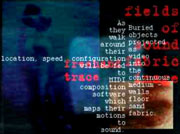
From Representation to Performance:
Responsive Public Space
Sha Xin Wei, sponge & Georgia Tech, email
Maja Kuzmanovic, FoAM, email
abstract
What is the public sphere in cyberspace?
What should the public sphere in cyberspace be?
What should we do with the public sphere in cyberspace?
What can we do with the public sphere in cyberspace?
We approach these questions by embedding them in two ways, historical and material.
We ask: "What alternative ways of being together in public evolved over the centuries since the Greek agora?" and "What in fact is this stuff that cyberspace and public sphere are made of?"
Overall, our paper has three threads. In the first thread we concisely review some of the common terms of the debate about cyberspace and the public sphere. In the second thread, we provide a few evocative descriptions of social spaces and events whose roots precede the industrial age.
In the third thread, we propose a structural critique of how information and network technologies are designed, and propose an alternative approach to public space in the information age. We offer some ways to rethink how such technologies can be embedded in historically- as well as ontologically rich ways that could support life-giving aspects of the public.
We point to experimental hybrid media events being built by our association, sponge, that make concrete some of the concerns and approaches we highlight in the paper.
Major points:
- Looking at the history of public spaces, we realize that spectrum
of public action is much richer than what we typically see in modern
informatic abstractions of the market and the agora.
As many performance theory studies show us, much alternative public action is swept into the category of play, which we explore through projects such as sponge. - We shift attention from representation to performance. We make the
move from maintaining representations of society to performing socially,
and gain more supple ways of building and inhabiting settings for public
activity.
- We shift attention from alphabets and objects to substrate and field. This is analogous to shifting the concern of a municipal public commission from the shape of the windows or the kind of fixtures on a specific house, to the Earth on which- and the materials out of which people build their homes.
- We shift attention from purely digital representation and simulation to material, embodied experience, augmented by responsive digital media.
- We explore responsive spaces with art and speculative design as well as techno-scientific research.
1. Problematic Promises: Cybernetics & Information Theory
In the last few decades, we have witnessed the penetration of cybernetic and information-theoretic habits of thought far beyond their original domains. "Languaging" has now been replaced by the exchange of data, of information about events. Information is the universal solvent that reduces all forms of human experience to equivalencies. Overloaded with information, we circle, as lost satellites, around a decentralized freedom.
The society lost the sense of community, it became a place of pure exchange. Every individual "Self" took the role of the "Other" on its shoulders, the role of creating difference, but as 'the essence of the otherness of the other lies in (...) indifference' (Karatani) the 'differentiated' information flows freely, but unnoticed. Karatani captured this reduction to transactions that become meaningless when we give up the collective construction of meaning. Therefore, the multidisciplinary debate about the re/construction of public space is one of the most crucial discussions for the evolution of the future societies.

Corso Saint Francoise 1905

from TGarden Installation concept
back to sponge >